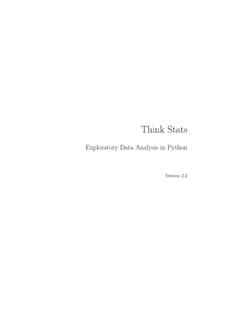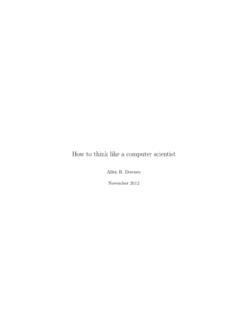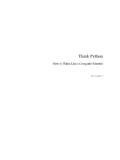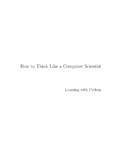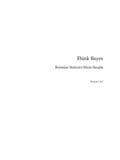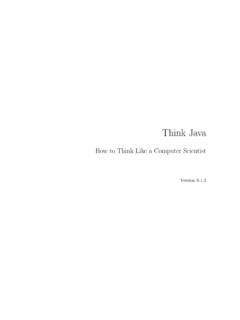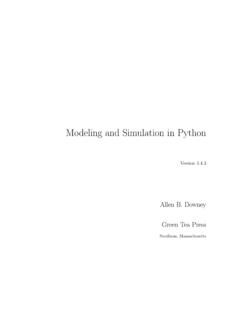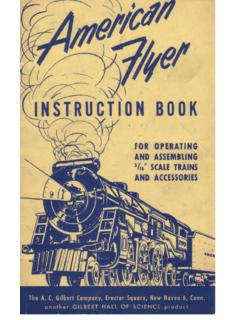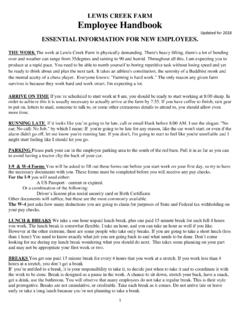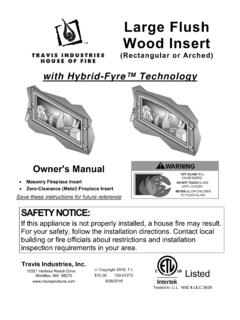Transcription of Learning Perl the Hard Way - Green Tea Press
1 Learning perl the hard Way ii Learning perl the hard Way Allen B. Downey Version April 16, 2003. c 2003 Allen Downey. Copyright Permission is granted to copy, distribute, and/or modify this document under the terms of the GNU Free Documentation License, Version or any later version published by the Free Software Foundation; with no Invariant Sections, with no Front-Cover Texts, and with no Back-Cover Texts. A copy of the license is included in the appendix entitled GNU Free Documentation License.. The GNU Free Documentation License is available from or by writing to the Free Software Foundation, Inc.
2 , 59 Temple Place, Suite 330, Boston, MA 02111-1307, USA. The original form of this book is LATEX source code. Compiling this LATEX. source has the effect of generating a device-independent representation of the book, which can be converted to other formats and printed. The LATEX source for this book is available from This book was typeset using LATEX. The illustrations were drawn in xfig. All of these are free, open-source programs. Contents 1 Arrays and Scalars 1. Echo .. 1. Errors .. 3. Subroutines .. 4. Local variables .. 4. Array elements.
3 4. Arrays and scalars .. 5. List literals .. 6. List assignment .. 6. The shift operator .. 7. File handles .. 7. cat .. 8. foreach and @ .. 9. Exercises .. 10. 2 Regular expressions 11. Pattern matching .. 11. Anchors .. 12. Quantifiers .. 12. Alternation .. 13. Capture sequences .. 14. Minimal matching .. 14. Extended patterns .. 15. vi Contents Some operators .. 15. Prefix operators .. 16. Subroutine semantics .. 17. Exercises .. 18. 3 Hashes 19. Stack operators .. 19. Queue operators .. 20. Hashes .. 20. Frequency table .. 21.
4 Sort .. 23. Set membership .. 24. References to subroutines .. 24. Hashes as parameters .. 25. Markov generator .. 26. Random text .. 28. Exercises .. 29. 4 Objects 31. Packages .. 31. The bless operator .. 32. Methods .. 32. Constructors .. 34. Printing objects .. 34. Heaps .. 35. Heap::add .. 35. Heap::remove .. 36. Trickle up .. 37. Trickle down .. 40. Exercises .. 42. Contents vii 5 Modules 43. Variable-length codes .. 43. The frequency table .. 44. Modules .. 45. The Huffman Tree .. 45. Inheritance .. 48. Building the Huffman tree.
5 48. Building the code table .. 49. Decoding .. 50. 6 Callbacks and pipes 53. URIs .. 53. HTTP GET .. 54. Callbacks .. 55. Mirroring .. 55. Parsing .. 56. Absolute and relative URIs .. 58. Multiple processes .. 58. Family planning .. 59. Creating children .. 59. Talking back to parents .. 60. Exercises .. 61. viii Contents Chapter 1. Arrays and Scalars This chapter presents two of the built-in types, arrays and scalars. A scalar is a value that perl treats as a single unit, like a number or a word. An array is an ordered collection of elements, where the elements are scalars.
6 This chapter describes the statements and operators you need to read command- line arguments, define and invoke subroutines, parse parameters, and read the contents of files. The chapter ends with a short program that demonstrates these features. In addition, the chapter introduces an important concept in perl : context. Echo The UNIX utility called echo takes any number of command-line arguments and prints them. Here is a perl program that does almost the same thing: print The program contains one print statement. Like all statements, it ends with a semi-colon.
7 Like all generalizations, the previous sentence is false. This is the first of many times in this book when I will skip over something complicated and try to give you a simple version to get you started. If the details are important later, we'll get back to them. The operand of the print operator is The at symbol indicates that @ARGV is an array variable; in fact, it is a built-in variable that refers to an array of strings that contains whatever command-line arguments are provided when the program executes. There are several ways to execute a perl program, but the most common is to put a shebang line at the beginning that tells the shell where to find the program called perl that compiles and executes perl programs.
8 On my system, I typed whereis perl and found it in /usr/bin, hence: 2 Arrays and Scalars #!/usr/bin/ perl print I put those lines in a file named , because files that contain perl pro- grams usually have the extension pl. I used the command $ chmod +ox to tell my system that is an executable file, so now I can execute the program like this: $ . Now would be a good time to put down the book and figure out how to execute a perl program on your system. When you get back, try something like this: $ . command line arguments commandlinearguments$.
9 Sure enough, it prints the arguments you provide on the command line, although there are no spaces between words and no newline at the end of the line (which is why the $ prompt appears on the same line). We can solve these problems using the double-quote operator and the n sequence. print It might be tempting to think that the argument here is a string, but it is more accurate to say that it is an expression that, when evaluated, yields a string. When perl evaluates a double-quoted expression, it performs variable interpolation and backslash interpolation.
10 Variable interpolation: When the name of a variable appears in double quotes, it is replaced by the value of the variable. Backslash interpolation: When a sequence beginning with a backslash (. ) appears in double quotes, it is replaced with the character specified by the sequence. In this case, the n sequence is replaced with a single newline character. Now when you run the program, it prints the arguments as they appear on the command line. $ . command line arguments command line arguments $. Since the output ends with a newline, the prompt appears at the beginning of the next line.

